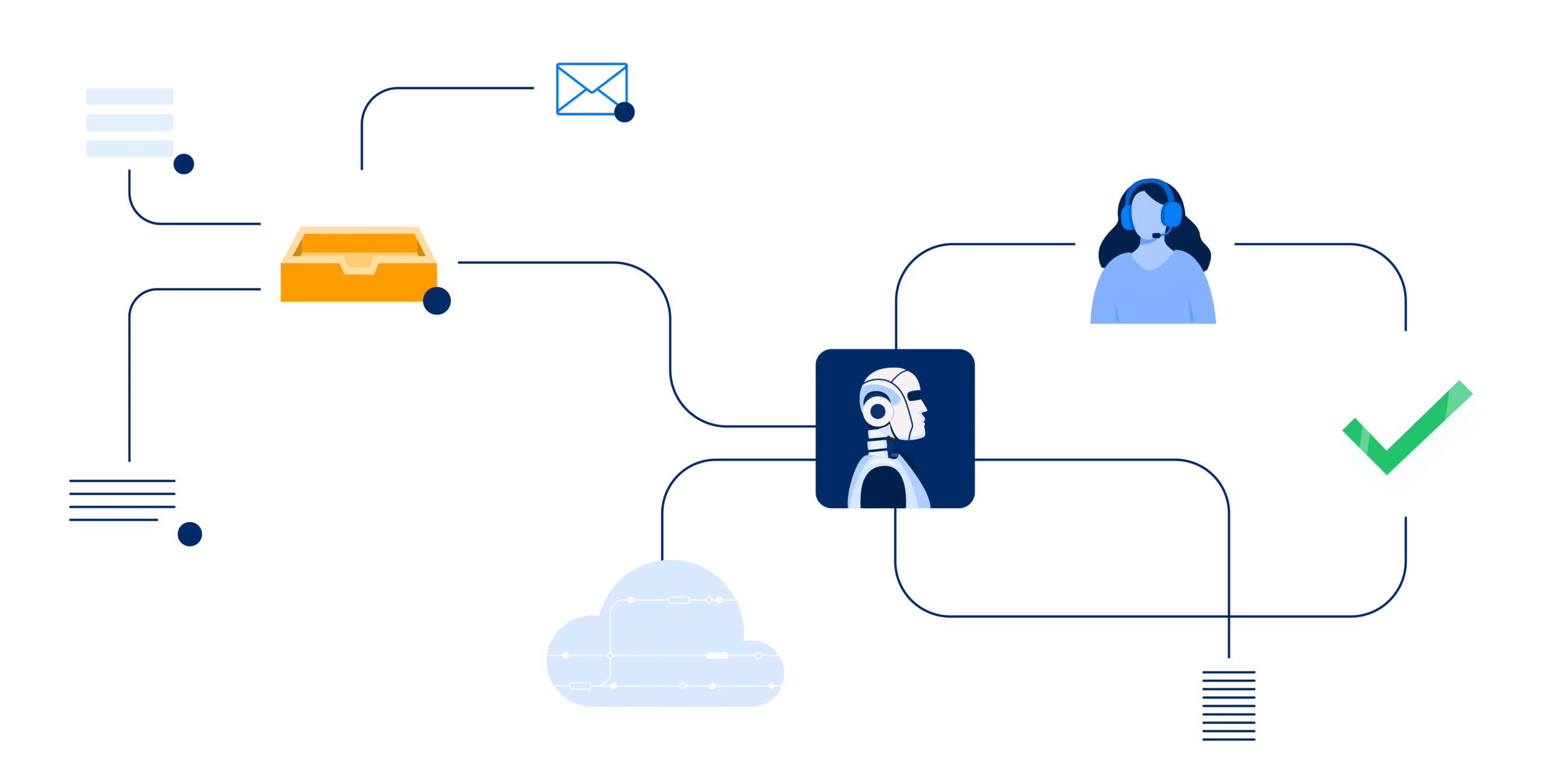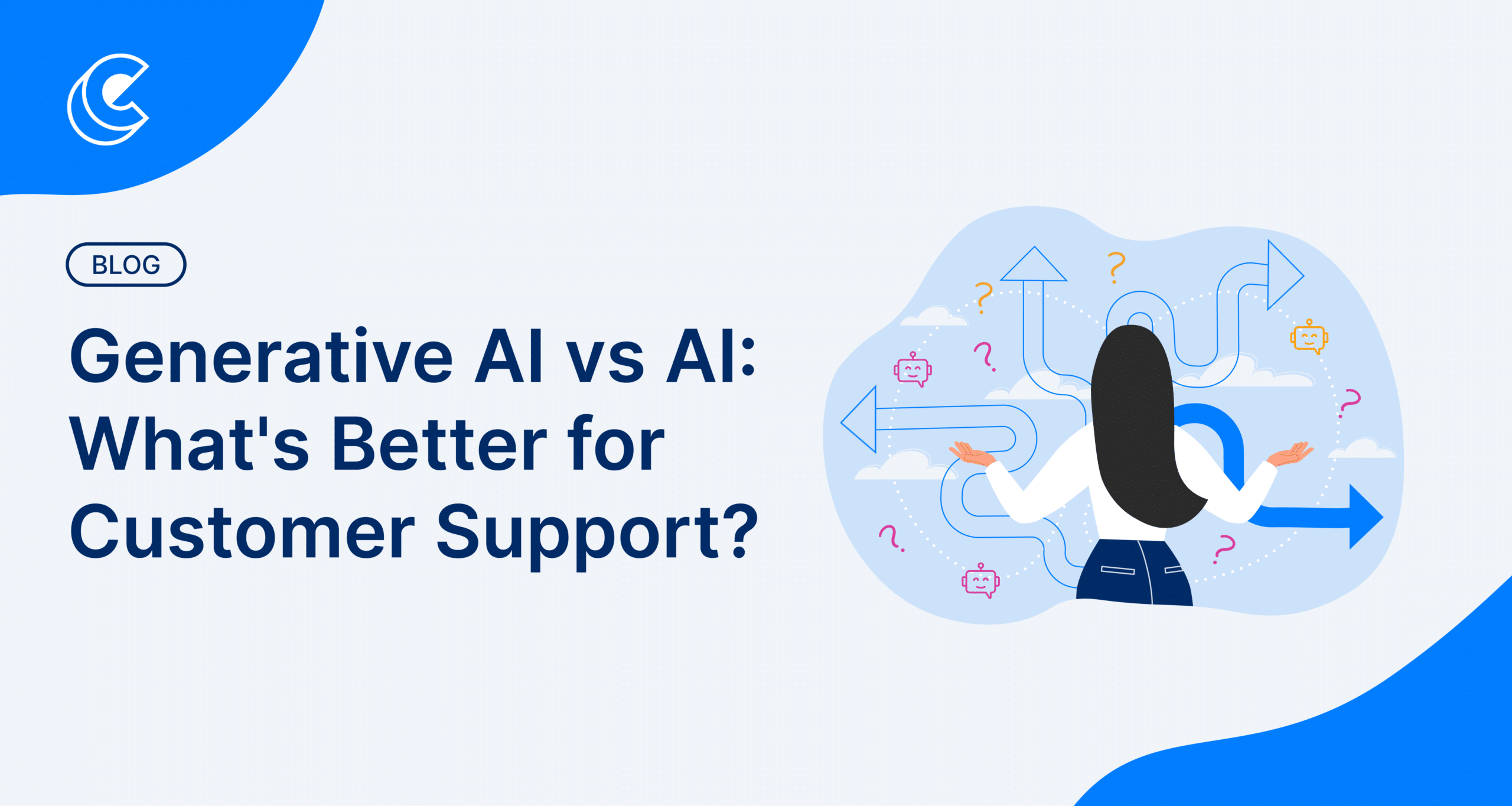Just like the internet and email before it, AI is revolutionizing the way we work. But it can be tough to keep up with the terminology. With more and more workers turning to AI to alleviate overwhelming workloads—68% of workers struggle with the pace and volume of work—it’s important to know exactly what AI can do, and what kind of return it can offer customer support teams. So, what’s better for customer support, generative AI vs AI? And what’s the difference?
Generative AI vs AI: What’s the Difference?
Traditional AI uses pre-set rules and predictive models to identify patterns or make predictions. It can identify spam emails, for example, or detect fraud.
Generative AI learns from large data sets to create new pieces of content. After analyzing existing examples, it can generate new text, images, video, sounds, and more.
In short, traditional AI predicts, while generative AI creates. When it comes to generative AI vs AI, one isn’t better than the other; rather, they are two sides of the same coin. Both are helpful and necessary tools for customer support.
What Can Generative AI do for Customer Support?
Generative AI has taken the world by storm in the past couple years. Every prominent technology platform from social media apps to project management tools now use generative AI in some way. For customer support leaders, generative AI is an invaluable tool for creating more seamless, personalized, and cost-efficient experiences.
Any business with support needs can now manage customer interactions across chat and email with generative AI. Let’s dive in to how it works:
- Personalized interactions: Imagine a customer email with a complex question. Generative AI doesn’t just respond; it crafts a response that feels personal and precise. It can match brand voice, ensuring consistency, as well as understand context and nuance. With generative AI support, customers feel more heard and understood.
- Higher satisfaction: Because generative AI uses your company’s knowledge, every answer it provides is accurate and relevant. Plus, it can work 24/7 across chat, email, and more, making self-service more effective, lowering call and ticket volumes, and ultimately reducing overall support costs.
- Adaptive learning: Generative AI is not static; rather, the more it’s used, the better it gets at answering questions effectively. This ensures that the content it generates is consistently accurate and up-to-date with the evolving nature of customer queries.
All-in-one omnichannel support platforms like Capacity use these generative AI tools to make support more efficient and effective while reducing overall costs.
Now that we’ve covered the generative AI part of the “generative AI vs AI” debate, let’s look at the other side of the story: practical AI.
What Can Practical AI Do for Customer Support?
Practical AI leverages rule sets to understand basic inquiries and make predictions. When it comes to customer support, practical AI does more than answer questions; it can collect customer information, kickstart and execute back-end processes, and even recognize callers’ voices. Here’s more about how practical AI works:
- Automated assistance: Using predetermined conversation flows and natural language understanding, practical AI can recognize when a customer needs more complex support than a simple question and answer—say, for example, they want to submit a claim or pay their bill via text message. Practical AI can help customers perform these tasks without distracting a human agent.
- Process automation: One strength often overlooked in the “generative AI vs AI” debate is practical AI’s ability to automate. It can independently handle routine tasks such as appointment scheduling and order management, freeing up human agents for more high-level projects while improving service efficiency.
- Voice support and authentication: AI isn’t just for written inquiries. Practical AI can also analyze a caller’s voice to seamlessly authenticate them, or recognize and transcribe their call. In this way, AI can reduce average handle time, eliminate customer frustration, and empower agents to offer higher quality support.
Practical AI is a great way to work more efficiently while ensuring that your overall process is effective and useful. But how do you choose which type of AI is better for your business?
It’s Not “Generative AI vs AI”, It’s Both
In debating “generative AI vs AI,” the ideal strategy for customer support leaders hoping to capitalize on new tech isn’t to choose one or the other—it’s to use both.
Ultimately, the challenge for customer support leaders in navigating “the generative AI vs AI” debate is understanding where each shines brightest. While generative AI is better for providing detailed, personalized responses, practical AI can perform quick back-end tasks that make the support process move more smoothly for both customers and teams.
As AI becomes even more integrated, intuitive, and intelligent, leaders must start thinking about how to meet the evolving needs of their customers with effective tools. Practical and generative AI both offer significant cost and time savings that create more seamless, satisfying customer and employee experiences.
Capacity uses both practical and generative AI to automate support interactions across web, chat, SMS, voice, email, and more—all in one platform. By combining these two types of AI, we’re able to deflect over 90% of support inquiries from both customers and teams…all so you can do your best work.
Ready to learn more? Read our guidebook, The State of Support Automation, to learn how to integrate AI into your support strategy today.

The Guide to Support Automation
Discover:
- The different types of AI
- A framework for applying support automation
- Tips for choosing solutions











































